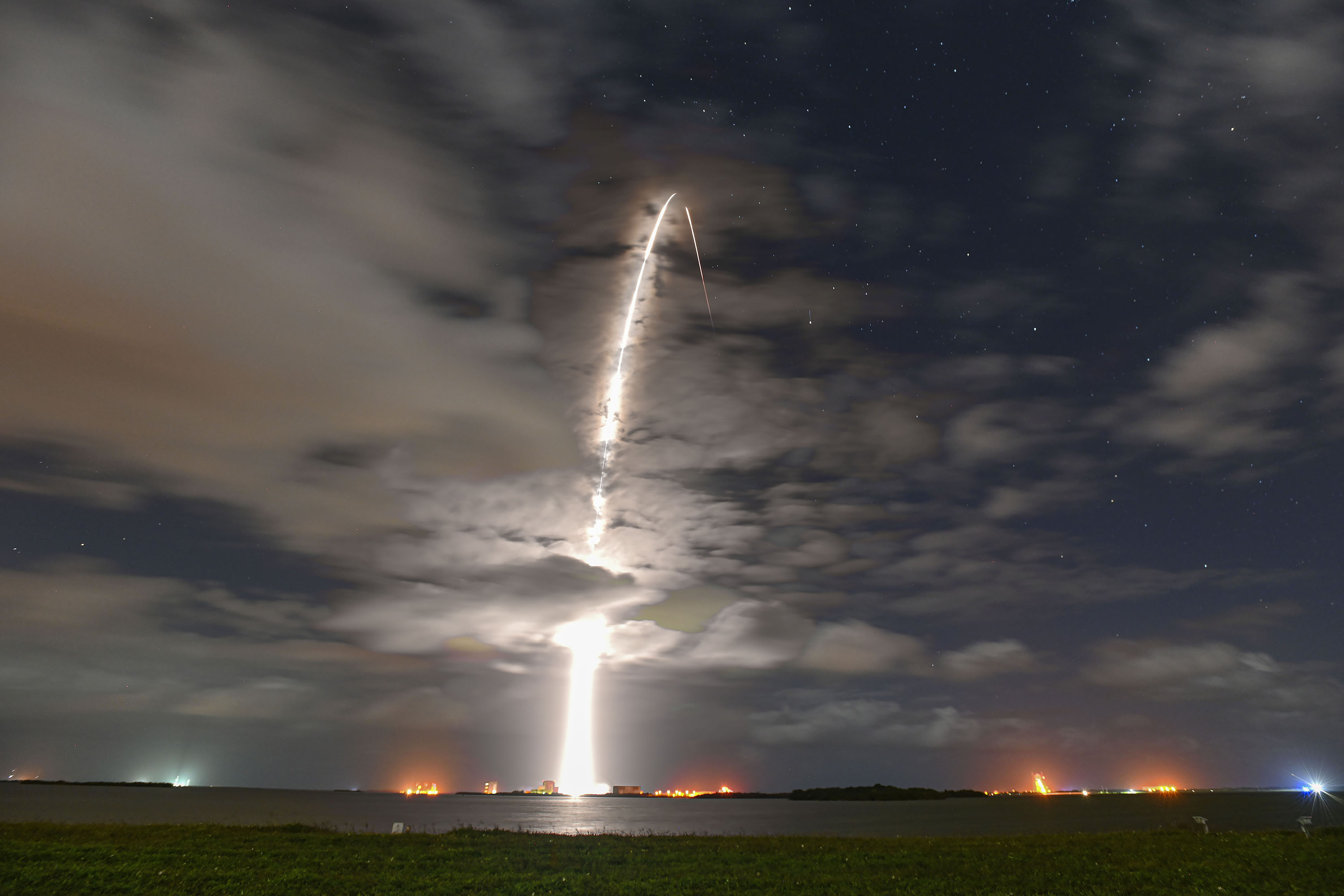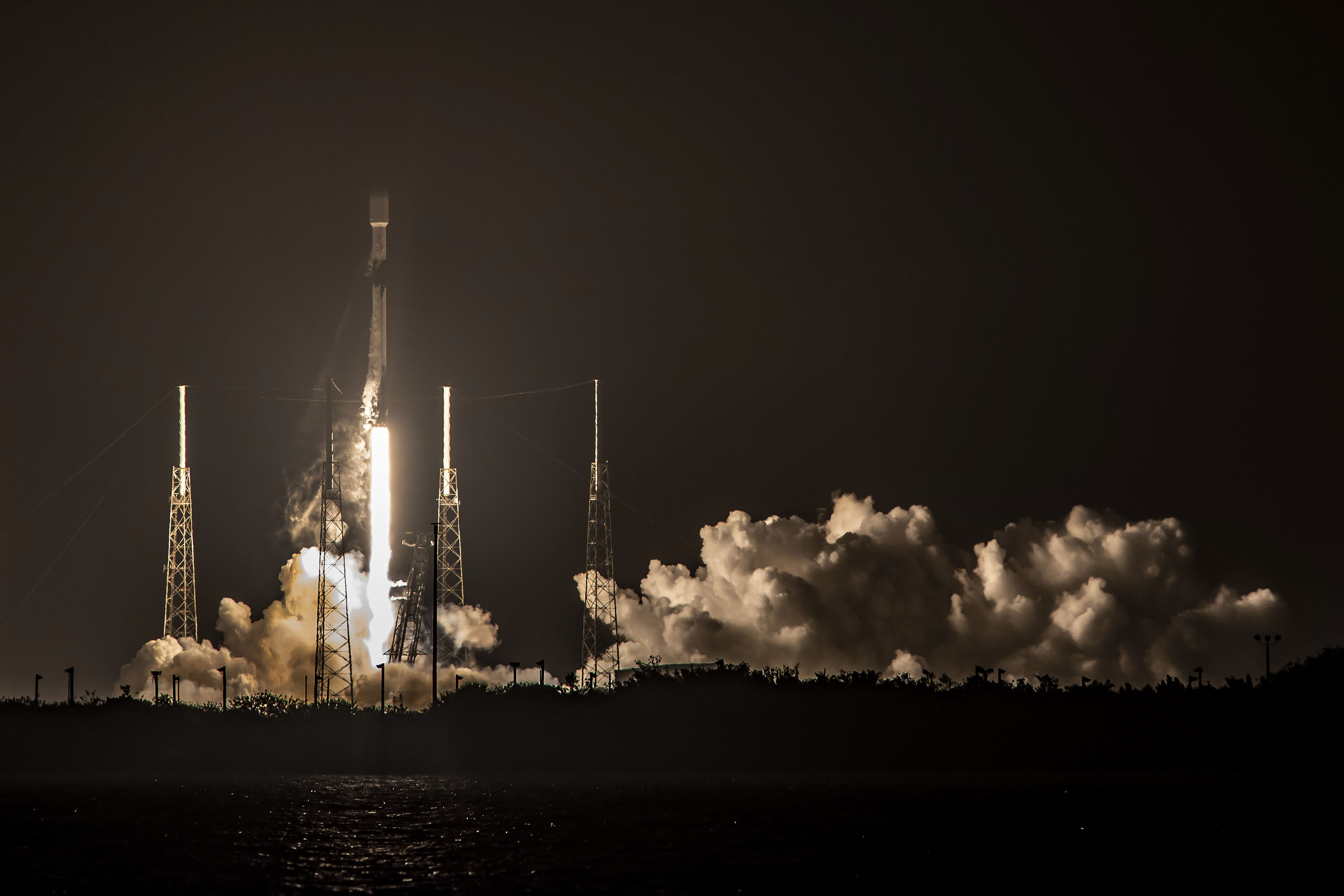SpaceX rocket launches for record 7th time, nails landing at sea in 100th Falcon 9 mission
SpaceX keeps setting reuse records.
CAPE CANAVERAL, Fla. — SpaceX just launched one of its Falcon 9 rockets for a record seventh time. The booster carried a full stack of 60 Starlink internet satellites into orbit and then nailed a landing at sea.
The two-stage Falcon 9 rocket blasted off from Space Launch Complex 40 here today (Nov. 24) at Cape Canaveral Air Force Station at 9:13 p.m. EDT (0213 GMT on Nov. 25), marking the company’s 23rd launch of the year and the 100th flight overall for the workhorse Falcon 9.
Approximately 9 minutes later, the booster's first stage returned to Earth, landing on one of SpaceX's drone ships in the Atlantic Ocean in a smooth touchdown. The massive ship, called "Of Course I Still Love You," is one of two in the company’s fleet of recovery vessels that catch falling boosters and return them to port.
"For the seventh time, this Falcon has landed," SpaceX engineer Kate Tice said during the live launch broadcast.
Related: SpaceX's Starlink satellite megaconstellation launches in photos

This was the third attempt to get this mission off the ground. SpaceX originally planned for a doubleheader over the weekend, as it successfully lofted the Sentinel-6 satellite into orbit for NASA and several partners, but then had to stand down from the Starlink try to do more checkouts on the rocket. Another attempt was scheduled for Monday (Nov. 23), but poor weather conditions at the recovery zone caused SpaceX to postpone the flight an additional 24 hours.
There was rain over the Space Coast that cleared just before liftoff tonight. The rocket thundered overhead as it climbed through the clouds. As the rocket’s first stage was separating to head back to Earth, the clouds cleared and onlookers could see the second stage's single engine light up.
Get the Space.com Newsletter
Breaking space news, the latest updates on rocket launches, skywatching events and more!
The first-stage booster featured in today's flight, known as B1049, now has seven launches and landings under its belt — the first Falcon 9 with so much flight experience. This frequent flier has now ferried five different Starlink batches to space, as well as a set of Iridium NEXT satellites and the Telstar 18V mission. The landing today marked the 67th recovery of a Falcon first stage since SpaceX recovered its first booster in 2015.
Reusable rockets
Today's flight marked the 23rd SpaceX launch of 2020, the company's busiest launch year yet. (The previous record was set in 2018, when the company launched 21 times.) The flight also marks the 100th launch of a Falcon 9 rocket.
Last month, the California-based aerospace company reached its centennial milestone of 100 flights for its Falcon series of rockets, which also included the Falcon 1 and Falcon Heavy. The company released a video highlighting that achievement. But now the Falcon 9 has also reached 100 on its own.
SpaceX launched tonight's Starlink mission just hours after it test-fired its SN8 Starship rocket prototype in Texas. SN8's engines blazed for several seconds ahead of a planned test flight that could happen as early as next week.
2020 has already been a banner year for SpaceX. The record 23 launches include two different astronaut missions to the International Space Station in the past six months, the first-ever private crewed flights to the orbiting lab. This achievement is facilitated by SpaceX’s fleet of flight-proven boosters. SpaceX currently has 10 veteran boosters in its rocket reserves and three brand-new Heavy boosters that will be used for an upcoming military mission. SpaceX has relied on its frequent fliers, now having launched more refurbished rockets than new ones.

To kick off its era of rapid reusability, SpaceX debuted a souped-up version of its workhorse, the Falcon 9 Block 5 first stage, in 2018. This upgraded iteration received a host of new features, including a more robust thermal protection system, titanium grid fins, a more durable interstage (the hardware that connects the rocket’s two stages) and more powerful engines.
Now packing more than 1.7 million pounds of thrust, the upgraded Falcon 9 has performed reliably (though the rocket has experienced two launchpad aborts in recent months) since launching its first payload in 2018, a communications satellite for Bangladesh. With that 2018 launch, the company bid farewell to the moderately reusable Falcons of the past, ushering in a new era in which the same rocket has the capability of flying many times.
Ever since, SpaceX has been working to hone its reusable rocket technology. Its track record with flight-proven rockets even earned the company the right to launch U.S. military and national security payloads as well as astronauts on previously flown rockets.
And now the company has launched and landed the same rocket a record seven times.
Related: Hitch a ride to space (and back) on a SpaceX Falcon 9 in this awesome video
A Starlink megaconstellation
SpaceX has its sights set on Mars and hopes to help make humanity a multiplanetary species. To help raise the money to make that bold goal achievable, the company developed a plan to blanket Earth with internet coverage beamed down from a network of broadband satellites. This Starlink megaconstellation would consist of thousands of satellites, flying close to the planet in low Earth orbit.
With tonight's launch, the company has now sent more than 900 of the quarter-ton, flat-panel satellites into space — a milestone that will help SpaceX roll out its Starlink internet service. There are still regulatory hurdles to overcome and more satellites to launch before the service can be offered globally, but initial testing is promising, company representatives have said.
SpaceX’s Starlink megaconstellation has one main goal in mind: to provide more affordable high-speed internet access around the globe, especially for those in rural and remote areas. To that end, the company initially planned for a fleet of 1,440 satellites, but has since obtained approval for thousands more.
The U.S. Federal Communications Commission has granted SpaceX permission to launch as many as 12,000 of the flat-panel broadband satellites, but SpaceX may not stop there. The company has indicated it may seek approval to launch as many as 30,000 more Starlink satellites to beam down high-speed, low-latency internet signals.
Related: Why SpaceX's Starlink satellites caught astronomers off guard
Beta testing
The burgeoning internet service has already gone through a private beta-testing program where company employees put the broadband service through its paces. According to reports from SpaceX team members, current data indicates the service can support multiple high-definition streams at the same time.
SpaceX recently rolled out a public beta-testing program, inviting users to purchase the ground equipment and then test out the service. The test program, dubbed "Better Than Nothing Beta," requires users to purchase the Starlink ground equipment for $499 and then pay a $99 monthly fee for active service.
The initial public beta test was limited, but more invites are expected to go out in January before official service is rolled out. Project engineers held a Reddit AMA ("Ask Me Anything") over the weekend where they answered questions about the service.
"Starlink is an extremely flexible system and will get better over time as we make the software smarter. Latency, bandwidth and reliability can all be improved significantly," the engineers wrote under the Reddit username "DishyMcFlatface," SpaceX's nickname for the Starlink satellite dish.
The Starlink team also revealed that SpaceX is "steadily increasing network access over time to bring in as many people as possible," the team wrote on the AMA thread. "Notably, we're planning to move from a limited beta to a wider beta in late January, should give more users an opportunity to participate."
"Expect to see data speeds vary from 50Mbps [megabits per second] to 150Mbps and latency from 20ms [milliseconds] to 40ms over the next several months as we enhance the Starlink system. There will also be brief periods of no connectivity at all," said the invite, which was posted to Reddit by one user in Washington state and another in Wisconsin.
In the AMA, Starlink team members addressed questions about latency and dropouts that users were experiencing.
"You should think about communication between the Starlink dish and the satellite in space as a 'skinny beam' between Dishy and the satellite," they wrote. "So, as the satellite passes quickly overhead, if there is a branch or pole between the dish and satellite, you'll usually lose connection (note — obstructions generally cause outages and not reduced speeds!)."
The Starlink team also explained how the dish locates satellites. "[The dish] is able to electronically scan the sky in a matter of milliseconds and lock into the satellite overhead, even though it's traveling 17,500 mph overhead," DishyMcFlatface answered. "When it detects a satellite, the Starlink hones in on its position and makes a request to join the internet. After that, the dish is able to download a schedule of which satellites to talk to next, and with that it can point right at the satellites when the time comes."
The Starlink team also said that they’re open to ideas from users on how to improve the plug-and-play experience. "We've spent a lot of effort and have gone through tons and tons of creative ideas on how to make this as simple of an experience as possible — including mounting solutions, automated pointing of the dish, and general unboxing," project engineers wrote.
Dynamic duo
As part of its recovery efforts, SpaceX deployed one of its twin fairing catcher boats — GO Ms. Chief. (Payload fairings surround satellites, protecting them during launch. SpaceX fairings come back to Earth in two pieces.)
The other boat, GO Ms. Tree, is still sidelined after it was damaged on a previous mission. The ship has been spotted leaving Port Canaveral this week and potentially conducting a few sea trials before it jumps back into service.
To assist GO Ms. Chief, one of SpaceX’s Dragon recovery vessels, GO Searcher, has been converted into a fairing catcher to help assist recovery efforts in the meantime.
Recovery efforts with GO Ms. Chief should happen about 45 minutes after launch.
Follow Amy Thompson on Twitter @astrogingersnap. Follow us on Twitter @Spacedotcom or Facebook.
Join our Space Forums to keep talking space on the latest missions, night sky and more! And if you have a news tip, correction or comment, let us know at: community@space.com.

Amy Thompson is a Florida-based space and science journalist, who joined Space.com as a contributing writer in 2015. She's passionate about all things space and is a huge science and science-fiction geek. Star Wars is her favorite fandom, with that sassy little droid, R2D2 being her favorite. She studied science at the University of Florida, earning a degree in microbiology. Her work has also been published in Newsweek, VICE, Smithsonian, and many more. Now she chases rockets, writing about launches, commercial space, space station science, and everything in between.









